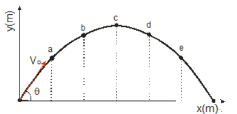Multiple Choice
Use the figure to answer the question.
The figure represents the parabolic trajectory of a ball going from a to e in Earth gravity but without air resistance. The initial velocity of the ball is Vo at an angle  to the horizon. The vertical dashed lines represent equal time interval,
to the horizon. The vertical dashed lines represent equal time interval, 

-The vertical velocity at point b is: Note: (g = 9.81 m/s2)
A) 0
B) Vo cos ( ) - ½ g (2 t) 2
C) Vo sin ( ) - ½ g (2 t) 2
D) Vo sin ( ) + ½ g (2 t) 2
E) Vo cos ( ) + ½ g (2 t) 2
Correct Answer:

Verified
Correct Answer:
Verified
Q6: A projectile is ejected from a 25-m
Q7: Use the figure to answer the
Q8: The displacement of a particle is _
Q9: A car is traveling east at 50
Q10: Use the figure to answer the question.<br>The
Q12: A projectile is fired with an initial
Q13: A baseball is thrown with a
Q14: The initial path of a rocket is
Q15: A vector has an x component of
Q16: An airplane is heading due east.The airspeed